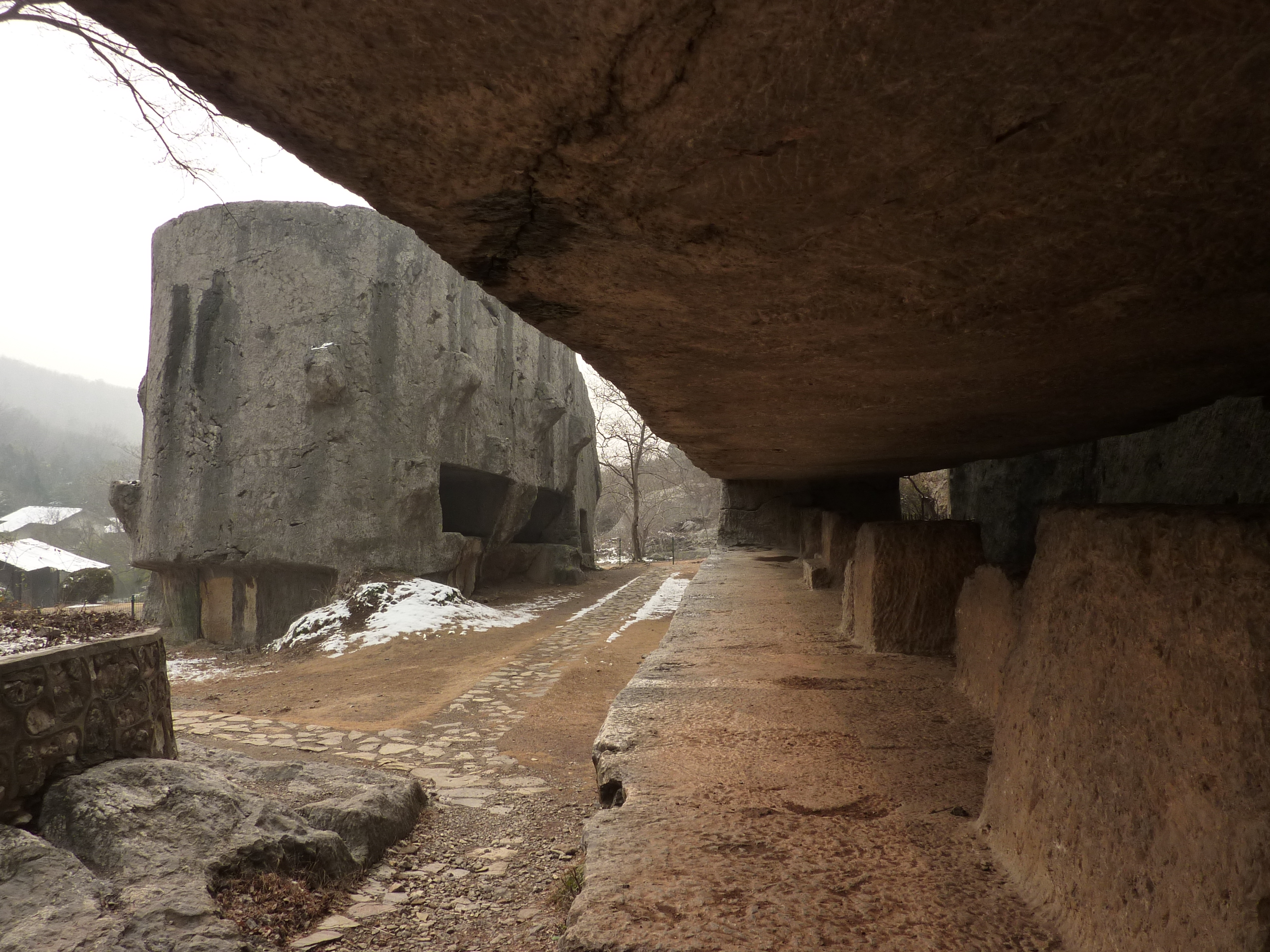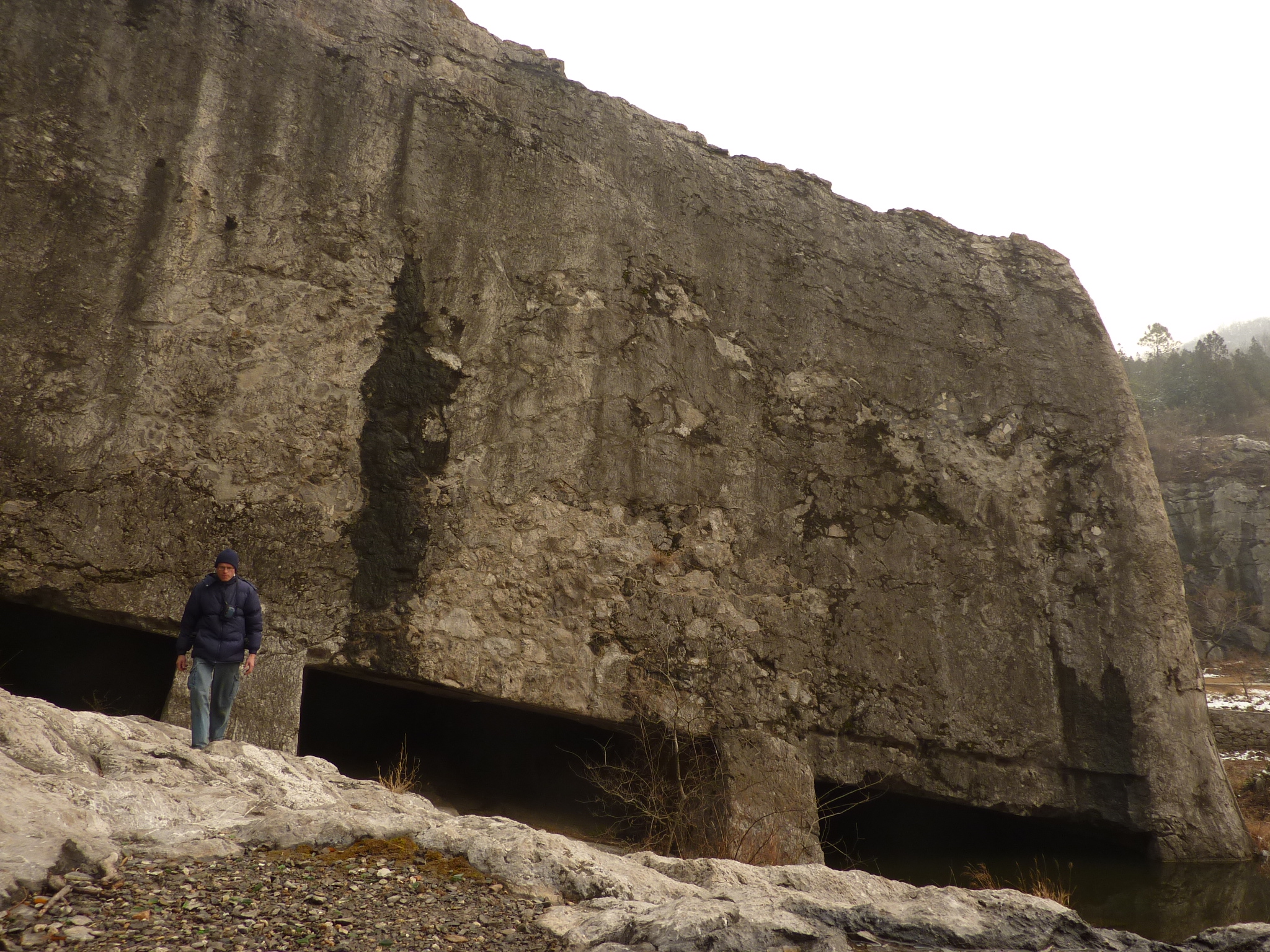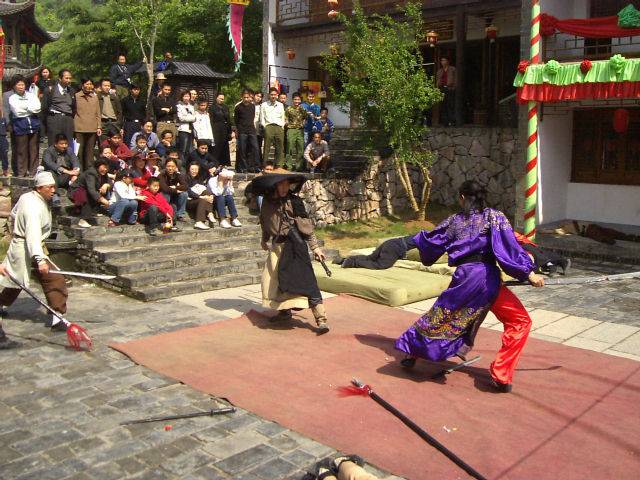Yangshan Quarry on:
[Wikipedia]
[Google]
[Amazon]
 The Yangshan Quarry () is an ancient stone quarry near
The Yangshan Quarry () is an ancient stone quarry near
 The Yangshan Quarry is situated on the Yangshan Mountain (elevation 140 m),
also known as Yanmen Shan (),
northwest of Tangshan Town ().
The Yangshan is the main peak of the Kongshan Mountain Range (). The site is located 15–20 km to the east from the eastern part of Nanjing City Wall and the Ming Xiaoling Mausoleum. Administratively, the area is in the
The Yangshan Quarry is situated on the Yangshan Mountain (elevation 140 m),
also known as Yanmen Shan (),
northwest of Tangshan Town ().
The Yangshan is the main peak of the Kongshan Mountain Range (). The site is located 15–20 km to the east from the eastern part of Nanjing City Wall and the Ming Xiaoling Mausoleum. Administratively, the area is in the

 The Yangshan Quarry has been worked from the time of the
The Yangshan Quarry has been worked from the time of the
YANGSHAN TABLET - THE FIRST TABLET IN THE WORLD / 阳山碑材天下第一碑
for the commonly given weight estimates. Their sizes are slightly different from those in Yang and Lu, which is not surprising, since the stone monoliths, after all, are not completely separated from the solid rock below. * The Stele Body (), long (this would be the height, if the stele were to be properly installed), wide, thick, 8,799 tons. * The Stele Head (), tall, wide, thick, 6,118 tons. According to experts, if the stele had been finished and put together, by installing the stele body vertically on the base, and topping with the stele head, then it would have stood tall. For comparison, the ''Shengong Shengde'' Stele actually installed in Ming Xiaoling is tall ( body + crown, on top of a tall tortoise pedestal). The Song-dynasty (early 12th century) ''Wan Ren Chou'' ("Ten Thousand Men's Sorrow") Stele in
Sons of the Yellow Emperor
. 2011-07-31, ''China Daily''. (This appeared in the hard copy of the newspaper on 2011-08-01)
 In 1956, the Yangshan Quarry was entered on the
In 1956, the Yangshan Quarry was entered on the
Nanjing
Nanjing (; , Mandarin pronunciation: ), Postal Map Romanization, alternately romanized as Nanking, is the capital of Jiangsu Provinces of China, province of the China, People's Republic of China. It is a sub-provincial city, a megacity, and t ...
, China. Used during many centuries as a source of stone for buildings and monuments of Nanjing, it is preserved as a historic site. The quarry is famous for the gigantic unfinished stele
A stele ( ),Anglicized plural steles ( ); Greek plural stelai ( ), from Greek language, Greek , ''stēlē''. The Greek plural is written , ''stēlai'', but this is only rarely encountered in English. or occasionally stela (plural ''stelas'' or ...
that was abandoned there during the reign of the Yongle Emperor
The Yongle Emperor (; pronounced ; 2 May 1360 – 12 August 1424), personal name Zhu Di (), was the third Emperor of the Ming dynasty, reigning from 1402 to 1424.
Zhu Di was the fourth son of the Hongwu Emperor, the founder of the Ming dyn ...
in the early 15th century. In scope and ambition, the stele project is compared to other public works projects of Yongle era, which included the launching of the treasure fleet for Zheng He's maritime expeditions and the construction of the Forbidden City
The Forbidden City () is a palace complex in Dongcheng District, Beijing, China, at the center of the Imperial City of Beijing. It is surrounded by numerous opulent imperial gardens and temples including the Zhongshan Park, the sacrifi ...
in Beijing.
Location
Jiangning District
Jiangning District () is one of 11 districts of Nanjing, the capital of Jiangsu province, China. The District has a population of 1,025,000 and an area of 1600 square kilometers. It includes southern and south-eastern suburbs of Nanjing.
Jiangnin ...
of Nanjing City, Jiangsu
Jiangsu (; ; pinyin: Jiāngsū, alternatively romanized as Kiangsu or Chiangsu) is an eastern coastal province of the People's Republic of China. It is one of the leading provinces in finance, education, technology, and tourism, with it ...
Province.
History
Six Dynasties
Six Dynasties (; 220–589 or 222–589) is a collective term for six Han-ruled Chinese dynasties that existed from the early 3rd century AD to the late 6th century AD. The Six Dynasties period overlapped with the era of the Sixteen Kingdoms ...
, the local limestone
Limestone ( calcium carbonate ) is a type of carbonate sedimentary rock which is the main source of the material lime. It is composed mostly of the minerals calcite and aragonite, which are different crystal forms of . Limestone forms w ...
being used for construction of buildings, walls, and statues in and around Nanjing.
After Zhu Yuanzhang
The Hongwu Emperor (21 October 1328 – 24 June 1398), personal name Zhu Yuanzhang (), courtesy name Guorui (), was the founding emperor of the Ming dynasty of China, reigning from 1368 to 1398.
As famine, plagues and peasant revolts i ...
(the Hongwu Emperor) founded the Ming dynasty
The Ming dynasty (), officially the Great Ming, was an Dynasties in Chinese history, imperial dynasty of China, ruling from 1368 to 1644 following the collapse of the Mongol Empire, Mongol-led Yuan dynasty. The Ming dynasty was the last ort ...
in 1368, the city of Nanjing
Nanjing (; , Mandarin pronunciation: ), Postal Map Romanization, alternately romanized as Nanking, is the capital of Jiangsu Provinces of China, province of the China, People's Republic of China. It is a sub-provincial city, a megacity, and t ...
became the capital city of his empire. The Yangshan quarry became the main source of stone for the major construction projects that changed the face of Nanjing.
In 1405, Hongwu's son, the Yongle Emperor
The Yongle Emperor (; pronounced ; 2 May 1360 – 12 August 1424), personal name Zhu Di (), was the third Emperor of the Ming dynasty, reigning from 1402 to 1424.
Zhu Di was the fourth son of the Hongwu Emperor, the founder of the Ming dyn ...
, ordered the cutting of a giant stele in this quarry, for use in the Ming Xiaoling Mausoleum of his deceased father. In accordance with the usual design of a Chinese memorial stele
A stele ( ),Anglicized plural steles ( ); Greek plural stelai ( ), from Greek language, Greek , ''stēlē''. The Greek plural is written , ''stēlai'', but this is only rarely encountered in English. or occasionally stela (plural ''stelas'' or ...
, three separate pieces were being cut: the rectangular stele base (pedestal), the stele body, and the stele head (crown, to be decorated with a dragon design). After most of the stone-cutting work had been done, the architects realized that moving stones that big from Yangshan to Ming Xiaoling, let alone installing them there in a proper way, would not be physically possible. As a result, the project was abandoned. In place of the stele, a much smaller tablet (still, the largest in the Nanjing area), known as the ''Shengong Shengde'' ("Divine Merits and Godly Virtues") Stele was installed in Ming Xiaoling
The Ming Xiaoling () is the mausoleum of the Hongwu Emperor, the founder of the Ming dynasty. It lies at the southern foot of Purple Mountain, located east of the historical centre of Nanjing. Legend says that in order to prevent robbery of the to ...
's "Square Pavilion" (Sifangcheng) in 1413.
The three unfinished stele components remain in Yangshan Quarry to this day, only partially separated from the solid rock of the mountain. The present dimensions and the usual weight estimates of the steles are as follows:
* The Stele Base (), long, thick, tall, 16,250 metric tons.See e.gYANGSHAN TABLET - THE FIRST TABLET IN THE WORLD / 阳山碑材天下第一碑
for the commonly given weight estimates. Their sizes are slightly different from those in Yang and Lu, which is not surprising, since the stone monoliths, after all, are not completely separated from the solid rock below. * The Stele Body (), long (this would be the height, if the stele were to be properly installed), wide, thick, 8,799 tons. * The Stele Head (), tall, wide, thick, 6,118 tons. According to experts, if the stele had been finished and put together, by installing the stele body vertically on the base, and topping with the stele head, then it would have stood tall. For comparison, the ''Shengong Shengde'' Stele actually installed in Ming Xiaoling is tall ( body + crown, on top of a tall tortoise pedestal). The Song-dynasty (early 12th century) ''Wan Ren Chou'' ("Ten Thousand Men's Sorrow") Stele in
Qufu
Qufu ( ; ) is a city in southwestern Shandong province, East China. It is located about south of the provincial capital Jinan and northeast of the prefectural seat at Jining. Qufu has an area of 815 square kilometers, and a total population of ...
, which is thought to be one of the tallest in China, is tall, wide, thick.Pauline D Loh,Sons of the Yellow Emperor
. 2011-07-31, ''China Daily''. (This appeared in the hard copy of the newspaper on 2011-08-01)
Cultural references
According to a legend, workers who failed to produce the daily quota of crushed rock of at least 33 '' sheng'' would be executed on the spot. In memory of the workers who died on the construction site—including those who died from overwork and disease—a nearby village became known as Fentou (), or "Grave Mound". Ann Paludan translates the place name as "Death's Head Valley". In the centuries since the giant stele project was abandoned, a number of Ming, Qing, and modern authors visited the site and left accounts of it. The poetYuan Mei
Yuan Mei (; 1716–1797) was a Chinese painter and poet of the Qing Dynasty. He was often mentioned with Ji Yun as the "Nan Yuan Bei Ji" ().
Biography
Early life
Yuan Mei was born in Qiantang (, in modern Hangzhou), Zhejiang province, to a cu ...
(1716 – 1797) expressed his feelings in "The Song of Hongwu's Great Stone Tablet" (), which concludes with "one hundred thousand camels could not move it!" (""). The poem is published in his collection ''Xiao Cangshan Fang Wenji'' ().
Present day
 In 1956, the Yangshan Quarry was entered on the
In 1956, the Yangshan Quarry was entered on the Jiangsu
Jiangsu (; ; pinyin: Jiāngsū, alternatively romanized as Kiangsu or Chiangsu) is an eastern coastal province of the People's Republic of China. It is one of the leading provinces in finance, education, technology, and tourism, with it ...
provincial register of protected cultural monuments. It is maintained as a tourist site, although, according to journalists who visited it at the turn of the 21st century, the site was little known even in Nanjing itself, and had few visitors.
A small theme park
An amusement park is a park that features various attractions, such as rides and games, as well as other events for entertainment purposes. A theme park is a type of amusement park that bases its structures and attractions around a central ...
called the Ming
The Ming dynasty (), officially the Great Ming, was an imperial dynasty of China, ruling from 1368 to 1644 following the collapse of the Mongol-led Yuan dynasty. The Ming dynasty was the last orthodox dynasty of China ruled by the Han pe ...
Culture Village (, ''Míng Wénhuà Cūn'') was constructed at the entrance to the site; as of 2011, it has a stage, children's rides, and various history-themed amusements. A single admission ticket allows one to visit the "village" and then to walk some to the quarry proper on one of several forest trails. The site is open year-round, but still is mostly deserted in winter.
Transportation from Nanjing to the Yangshan Quarry (either directly to the Ming Culture Village's entrance plaza, or to the "Yangshan Quarry" stop on the Jiangsu Provincial Highway 122 (S122)) is provided by several bus routes, including the Nanjing-Tangshan Line (, ''Nán-Tāng Xiàn'') from the Nanjing Railway Station.A 2011 Nanjing Public Transport Map
Notes
Literature
* * {{citation, title=大明帝国之朱棣卷 (The Book of Ming Empire's Zhu Di), last=Ma , first=Weiyuan (马渭源) , year=2011 , url=http://vip.book.sina.com.cn/book/catalog.php?book=175658, isbn=978-7-5641-2865-4 Quarries Surface mines in China Ming dynasty architecture History of Nanjing Buildings and structures in Nanjing Monoliths Tourist attractions in Nanjing